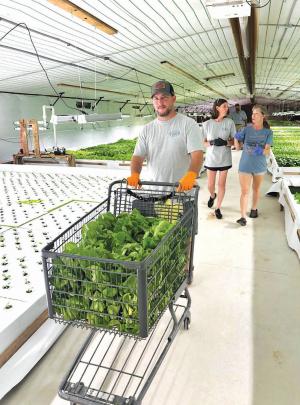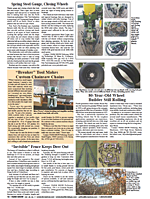2025 - Volume #49, Issue #5, Page #10
[ Sample Stories From This Issue | List of All Stories In This Issue | Print this story
| Read this issue]
Poultry To Produce Barn Conversion
 |
“It’s been a remarkable journey, taking 2 1/2 years to get where we are,” says Ferguson. “It’ll probably take another 3 to 4 years to get where we want it to go.”
Ferguson started with three 40 by 500-ft. chicken barns. The conversion involved clearing out existing equipment, trenching in plumbing for the hydroponic system, insulating the walls and ceiling, pouring concrete, and installing the hydroponic tanks, pumps and filters. Overall, it cost about $200,000. He believes this investment is already paying off.
“I made good money with the barns for 20 years,” he says. “With the hydroponics, I’ll make more money with one grow house than I did with three barns.”
Currently, his Riley Creek Farms produces 24,000 heads of lettuce every 30 days, using only half of one grow house. By late August, he’ll have nearly doubled production and will supply lettuce weekly to three school systems. Eventually, he plans to grow not only lettuce as his main crop but also cucumbers, tomatoes and strawberries. He’s adding Dutch buckets for vegetable production and towers for strawberries in a second house.
“Right now, we’re focusing on getting healthy, fresh food into our schools,” says Ferguson. “Next, we’ll focus on other local markets, including hospitals, nursing homes, restaurants and grocery stores.”
He notes that local schools have reported throwing out 40% of the lettuce they buy, which often spoils due to the distance it must be transported. He chafes at the waste of food and money.
“Our furthest school is 30 miles away,” says Ferguson. “They won’t get bad lettuce.”
He wants to serve as a resource for others interested in pursuing a similar endeavor and also as a classroom for students.
“I want to pass on the knowledge we’ve gained,” says Ferguson. “There are buildings all over the U.S. like mine, and nothing is wrong with them,” says Ferguson. “I want to help farmers figure out how to convert them to a new use.”
It’s knowledge he’s still gaining.
“We’re still in the learning process,” he says. “We’ve had issues. Lights are very important to us, and energy bills are very high. I think solar panels will be the answer. I don’t think it’ll pay with traditional energy.”
Ferguson is quick to credit his supporters, starting with his local bank. He also received a “Convert to Crops” grant from the Physicians Committee for Responsible Medicine, a nonprofit health organization. That grant funded hydroponic equipment and a refrigerated trailer for local deliveries. Alabama’s Farm-to-School program subsidizes schools’ purchasing of locally grown foods. HudsonAlpha Wiregrass’s “Navigate” program provided grants and technical guidance.
Ferguson was recently diagnosed with cancer and is undergoing treatment. Meanwhile, he’s moving full speed toward his goals, learning and sharing as he goes.
“There are only three of us in the state doing anything similar,” says Ferguson. “We’re all using different systems, but we talk to each other and feed off each other’s ideas. We’re learning every day and making changes as we go, sometimes daily. I want my neighbor to know what I’m doing, and that if it’ll help him, he can use it.”
Contact: FARM SHOW Followup, Riley Creek Farms, 12380 E. Hwy. 27, Newville, Ala. 36353 (ph 334-726-2425; rileycreekfarms@gmail.com; Facebook: Riley Creek Farms).

Click here to download page story appeared in.

Click here to read entire issue
To read the rest of this story, download this issue below or click here to register with your account number.




